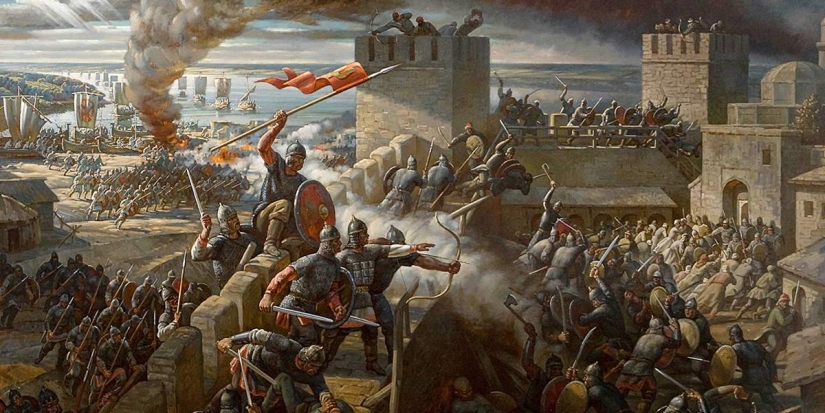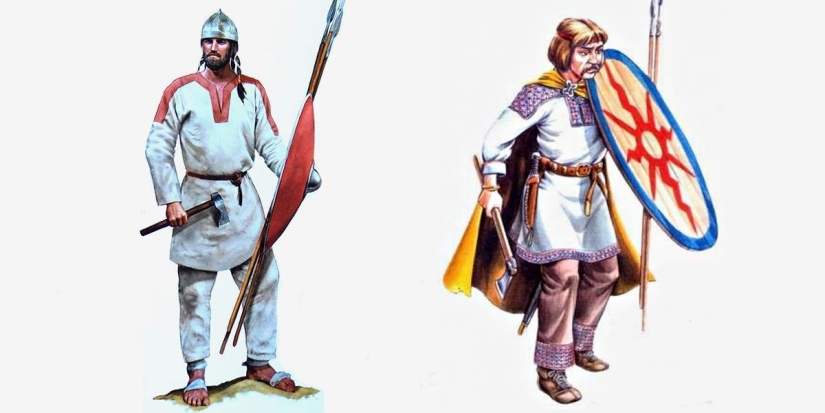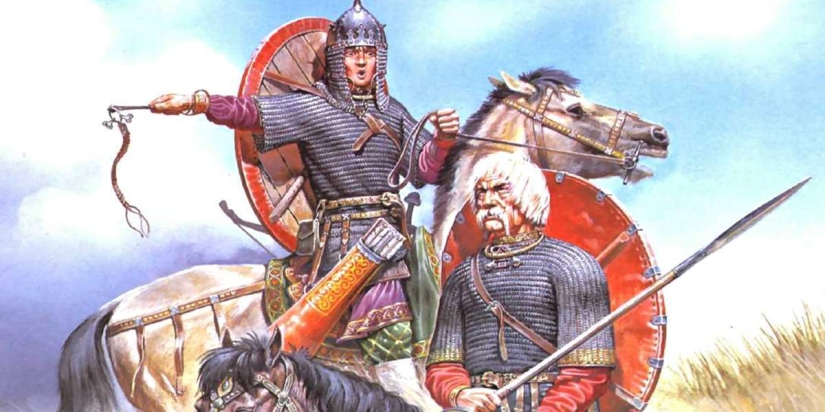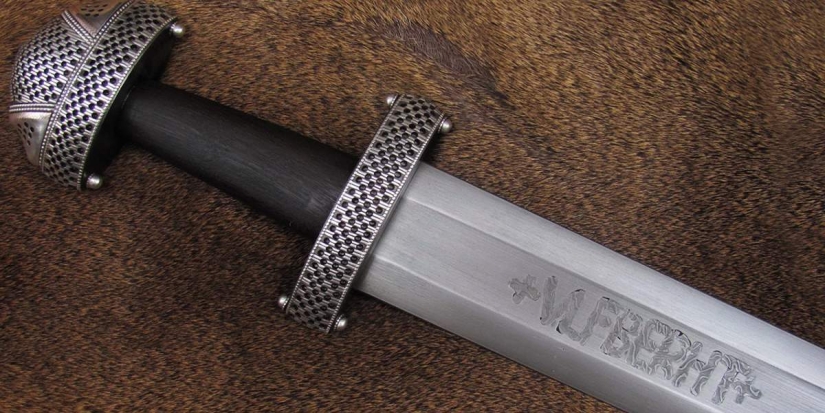10 "school" misconceptions about Russian military history
By the end of school everyone more or less gets the idea of the history of their country. However, usually it has quite little in common with modern scientific views. Some errors and obsolete statements have settled on the pages of textbooks, some are picked up from the mass consciousness. Take for example the military history of Russia. And note that in other countries are not better...


This was true of the era before. When the Slavs came out of the Pripyat marshes, looked around and began breeding unions to wander around Europe, kicking different the Romans, and sometimes even pillaging of the Vikings. Well agraba in response, where do without it. (Note: maybe not from Pripyat, and not swamps is the only one of the versions and also a bit of a myth.)

Russian soldiers at the end of X century. Reconstruction of the artist N. Zubkov
That's just by the time of Rurik, the Slavs have long since learned is bad. Layer of professional warriors preferred strong armor and swords from the best forges of Europe and the East. The design of the state and the dynasty finally sent tribal warriors in romantic shirts util — too little they live on the battlefield. War became engaged a small but experienced professionals-combatants. Went to beat the Romans, the Khazars and other Finno-Germans they're not shirts.

Replica sword from the collection of the Moscow Kremlin — stigma workshop Ulfbert, one of the best forges of the Rhine, speaks of the sword "premium"
Still, you can read about some of the fantastic Russian swords next to which even the Damascus blades I was ashamed to put. Unfortunately, there were these beautiful swords exclusively in romantic-Patriotic fantasies. For the simple reason that the quality of bog ore on the East European plain even normal armor is allowed to make from scratch.
Therefore, when we rightly laugh at the myths about supercasino, which in fact was forged out of very poor iron, it is worth remembering — it wasn't much better. Ancient warriors was not necessary, like the samurai, on the battlefield, straightening crooked swords just because from the Varangians to the Greeks went to the merchants and brought great swords from the best forges of the Rhine.
Purely Russian swords met — but very rarely. Popularity they enjoyed. Warrior need high-quality weapons, and the support of domestic producers let the Prince thinks. Well, do good own steel in Russia appeared only with the development of the Urals.
Well, not at all. Never no. Slavs mourn for some time under the power ready, and then went with the Huns in Europe — and it is the case like. So much so that in the next century got everyone and no one left hurt.
The ancestors of the Russians were no worse and no better. On the pages of Chronicles they burst into the light of the fires covered with blood, and carefully looted the cities of Byzantium and Persia. Then there was shield on the gates of Constantinople, the defeat of the then superpower of the Khazars, broke the desperate efforts of the Romans, the conquest of the great Bulgarian Kingdom. Princes went to beat and Rob the neighbors at the first opportunity in the Czech Republic, and Novgorod RAID party went to extort tribute from the land from Finland to Perm as a job. Peaceful, gentle Russians.
"The fight of Rus Pechenegs". Artist E. Emelyanov
But there is no beloved nationalists and romantics of all stripes epic confrontation was not. With steppe by the Russians and fought, and ally, and married almost herds. This time, harsh and brutal. Today, each other cut, walk tomorrow at the feast, and after that cut again — it happens.
Yeah, slept and seen. Not only Russian, and Baltic and elskie. The coast is delicious. The essence of the conflict the Russian principalities with the crusading Germans is a sphere of influence in the Baltic. The fact that many local tribes to the emergence in the Baltic States awards and bishoprics is not the first century they were tributaries of the Russian.
.
And in response to the deflection of a pair of small principalities in Livonia began to walk to the German comrades with sharp objects for the rapid resolution of commercial and tax disputes. With 1203 1234 years in eight major campaigns of "peaceful" Russian princes "aggressive" of the crusaders. For very good reason — a useful tribute to the Livs and Estonians.
And even the subsequent battle of the Ice was on the German site — knights and soldiers of the Bishop very badly and intercepted another visit "gentle and only defending" Russian, unhappy with the changing political landscape in the Pskov — and that's all.
The battle on the ice. Artist E. Emelyanov
But it was not. Or rather, was — but so few and rare, even exotic. Hiking on the ancient Viking tradition occasionally fought Novgorod — but the goal they got on boats or on the same horses. All other Rus, and Europe, from the late eleventh century, moved to the horses. Foot soldiers in most cases, only guarding the convoys — and all.
So Russian traditional men shirts with axes and Drin with paintings and movie frames — a tribute to Hobbies intellectuals of the XIX century romantic nationalism. And the result of the device of brains of the then military historians, from personal experience, in principle, not having imagined the war without masses of infantry with some cavalry support.
In the fields of real battles of the Russian middle ages unchallenged rules squad of cavalry. It fought in princely strife, died on the Kalka city, defeated on the banks of lake Peipsi and on the Kulikovo field. Then it was replaced by local cavalry — while the famous archers were in it only an auxiliary tool, worked mainly of field fortifications and artillery cover.
The castle of Castelvecchio in Verona
And also no. To verify this, it is enough to go, say, to Milan or Verona. Or at least see pictures of Castello Sforzesco.
Oh, it's the Kremlin! you say, and you will be absolutely right. For the Moscow Kremlin and all its derivatives up to Smolensk walls, created on the basis of Italian fortification school of the Renaissance. Initially the Italian masters.
Well, since the Italian fortification is not as well known as a cultural Renaissance masterpieces, and the Kremlin over the centuries have not come from the pages of European news — this style is considered to be almost a native Russian. However, typically Russian he really was. But the ears stick out from his purely Italian.
By the way, a related historical anecdote. The fact is that in Italy since the dismantling of the Guelphs and Ghibellines form of teeth of the fortress walls was a political issue. Supporters of the popes were doing the teeth of the rectangular fortresses. But supporters of the emperors — forked. Like the wings heraldic Imperial eagle.
When the question arose, what do the teeth of the Moscow Kremlin, after some thought decided: Orthodox sovereigns certainly nevmestno have on the fortress battlements as supporting the Vatican Guelph, — so may they be cloven!
Looks like Russian Bogatyr? A mighty warrior in mail, with shield and spear. However, instead of the old "armor" he often draw the armor of the XVII century, with beautiful armor shields of different types. Although they were used in times of d'artagnan and Richelieu, the heroic and not catching.
With a spear or an anachronism otherwise. The spear was the main weapon of Russian soldier-rider since the mass appearance of cavalry. But only till the middle of XV century. And then in the Grand Duchy of Moscow there was an armed revolution. In place of a powerful, but very expensive warriors-spearmen thoroughbred horses came weight local cavalry with steppe complex weapons.
Local horse archers
Since then, the main weapon of the Russian cavalry became bows and arrows — which eventually gave way to pistols. In the melee they fought with swords or Glaive-sunami. Ramming blow with a spear they apply could not, cheap horses and saddles of the steppe of the sample was allowed conveniently to turn and send arrows in any direction, but does not give focus back.
However, the soldiers of other Russian lands, Novgorod to Belaya Rus, longer said goodbye to copain fight. Some continued to specialize in it until the XVIII century. However, it was already hussar banners of the Commonwealth.
Head of the Streltsy prikaz, city Cossack and Sagittarius Polotsk "zheleznogo" order, 1550-70-Artist E. V. Golubev
The classic image of Sagittarius in a bright uniform with a frightening hammers at the ready lovely. Alas, reality it corresponds only in part.
First, they were not always red. Met Strelets orders — that is, the shelf — where the staff was blue, yellow, green kaftans. Red met more often — but they had up to six different regulated shades depending on division.
Regiments of foreign formation: Archer, shooting from the European musket, the Dragoons, and pikemen
And before that, they say, fought the old fashioned way. Homespun local cavalry and archers. Fortunately for the Russian, their rulers were not idiots. Military since a young Ivan the terrible has gone far ahead.
In the Confusion of the Moscow regiments fought shoulder to shoulder with the allied Swedes corps de La Gardie, and had the opportunity to observe more advanced and effective tactics. Then the new Tsar Mikhail Romanov made a huge effort to transform the Russian military machine in the most modern.
From Europe EN masse were invited experienced officers and whole regiments of mercenaries. In their image and likeness and with the active participation of "trainers of private military companies" were established regiments of the new system: foot soldiers and horse-riding talents.
Moscow archers in casual clothes, 1650-1660 E. figure C. Latina
In 1630, they demonstrated a much higher capacity to fight with troops of the Commonwealth, than the traditional manorial cavalry with archers. Because the beginning of a new big war in 1654, the main striking force of the army of Tsar Alexei Mikhailovich made up of numerous regiments of soldiers and cavalryman, trained by the most experienced European officers — veterans of the Thirty years war.
Outwardly, they looked like archers, but differed much higher discipline and a wide range of skills, able to smoothly maneuver on the battlefield and was armed with spikes to deter attacks by the cavalry. They defeated the formidable Litvinsky banners and came to Vilna and Kovno, demonstrating the increased power of the "legions of the Third Rome".
Peter well the reforms are not a fundamental breakthrough and shock the foundations, and next steps on the way, laid his Royal grandfather. And even more advanced Western European standards.
Charles XII
Uh-uh... how can I say this? Even in a school textbook, quite the opposite. But mentioned in passing and is eclipsed by Poltava Victoria. And what did the Swedes already at the Poltava and earlier in the Forest near Mogilev? That's right — Russia came to conquer. Well, and rightly got smacked.
In fact, it all started with the fact that Russia, Poland, Saxony and Denmark decided to punch Swedes and take their land on the southern and Eastern shores of the Baltic sea. That the Swedes, too, never white and fluffy, the previously pressed Russians, poles, Germans and Danes. And lived there and did mostly the Baltic States. That all this butting on the lands of the public is sincerely seen in the coffin. But their opinions on the ease of the then manners to ask anybody in a head has not come.
That's only when the Russians, the poles stated and Saxons, joined by the Danes went together to beat the Swedes — it turned as the old joke about a bear caught. Which, of course, caught only hunters that does not help. "The last Viking" and a fan of the war of Charles XII with his small but elite army high fanaticism and frostbite decided that "it's just a holiday!".
The battle of Poltava
He defeated at Narva by the invading Russians, with one blow knocked out of the war Denmark, followed by long chase across the expanses of the Commonwealth for the Saxon infantry and noble cavalry — until Tsar Peter urgently strengthened the long-suffering walls of the city and melted down the Church bells for the new guns to replace the lost at Narva.
Having dealt with the poles and Saxons, Charles XII went for a return visit to beat the Russians — that in the absence of squeezed-still a decent chunk of the Baltic States. To beat not work, when Forest had his first big fall out and epic alkatrim, and "Poltava" was in the Swedish language the same as "Berezina" in French. That's just the whole story — it does not about the ugly side of the European invaders that jerkiness of his character came again forcing good peaceful people.
Which, of course, never on anybody did not attack, and so built the biggest continental power. Such cases.
Keywords: Misleading | Compilation | Russia | School
